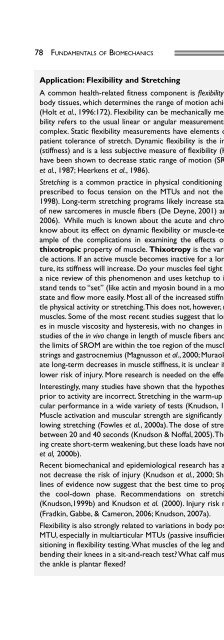Fundamentals of Biomechanics
Fundamentals of Biomechanics
Fundamentals of Biomechanics
You also want an ePaper? Increase the reach of your titles
YUMPU automatically turns print PDFs into web optimized ePapers that Google loves.
78 FUNDAMENTALS OF BIOMECHANICS<br />
Application: Flexibility and Stretching<br />
A common health-related fitness component is flexibility. Flexibility is defined as “the intrinsic property <strong>of</strong><br />
body tissues, which determines the range <strong>of</strong> motion achievable without injury at a joint or group <strong>of</strong> joints”<br />
(Holt et al., 1996:172). Flexibility can be mechanically measured as static and dynamic flexibility. Static flexibility<br />
refers to the usual linear or angular measurements <strong>of</strong> the actual limits <strong>of</strong> motion in a joint or joint<br />
complex. Static flexibility measurements have elements <strong>of</strong> subjectivity because <strong>of</strong> variations in testers and<br />
patient tolerance <strong>of</strong> stretch. Dynamic flexibility is the increase in the muscle group resistance to stretch<br />
(stiffness) and is a less subjective measure <strong>of</strong> flexibility (Knudson et al., 2000). Inactivity and immobilization<br />
have been shown to decrease static range <strong>of</strong> motion (SROM) and increase muscle group stiffness (Akeson<br />
et al., 1987; Heerkens et al., 1986).<br />
Stretching is a common practice in physical conditioning and sports. Stretching exercises must be carefully<br />
prescribed to focus tension on the MTUs and not the ligaments that maintain joint integrity (Knudson,<br />
1998). Long-term stretching programs likely increase static range <strong>of</strong> motion by stimulating the production<br />
<strong>of</strong> new sarcomeres in muscle fibers (De Deyne, 2001) and neuromuscular factors (Guissard & Duchateau,<br />
2006). While much is known about the acute and chronic effects <strong>of</strong> stretching on static flexibility, less is<br />
know about its effect on dynamic flexibility or muscle-tendon stiffness (see Knudson et al., 2000). One example<br />
<strong>of</strong> the complications in examining the effects <strong>of</strong> stretching by measuring muscle stiffness is the<br />
thixotropic property <strong>of</strong> muscle. Thixotropy is the variation in muscle stiffness because <strong>of</strong> previous muscle<br />
actions. If an active muscle becomes inactive for a long period <strong>of</strong> time, like sitting in a car or a long lecture,<br />
its stiffness will increase. Do your muscles feel tight after a long ride in the car? Enoka (2002) provides<br />
a nice review <strong>of</strong> this phenomenon and uses ketchup to illustrate its cause. A gel like ketchup if allowed to<br />
stand tends to “set” (like actin and myosin bound in a motionless muscle), but when shaken tends to change<br />
state and flow more easily. Most all <strong>of</strong> the increased stiffness in inactive muscles can be eliminated with a little<br />
physical activity or stretching.This does not, however, represent a long-term change in the stiffness <strong>of</strong> the<br />
muscles. Some <strong>of</strong> the most recent studies suggest that long-term effects <strong>of</strong> vigorous stretching are decreases<br />
in muscle viscosity and hysteresis, with no changes in tendon stiffness (Kubo et al., 2001a, 2002). Recent<br />
studies <strong>of</strong> the in vivo change in length <strong>of</strong> muscle fibers and tendons using ultrasound and MRI show that that<br />
the limits <strong>of</strong> SROM are within the toe region <strong>of</strong> the muscle and tendon load-deformation curve for the hamstrings<br />
and gastrocnemius (Magnusson et al., 2000; Muraoka et al., 2002). Even if consistent stretching did create<br />
long-term decreases in muscle stiffness, it is unclear if this would translate to improved performance or<br />
lower risk <strong>of</strong> injury. More research is needed on the effects <strong>of</strong> stretching on muscle stiffness.<br />
Interestingly, many studies have shown that the hypothesized performance-enhancing benefits <strong>of</strong> stretching<br />
prior to activity are incorrect. Stretching in the warm-up prior to activity has been shown to decrease muscular<br />
performance in a wide variety <strong>of</strong> tests (Knudson, 1999b; Magnusson & Renstrom, 2006; Shrier, 2004).<br />
Muscle activation and muscular strength are significantly decreased for 15 and 60 minutes, respectively, following<br />
stretching (Fowles et al., 2000a).The dose <strong>of</strong> stretching that significantly decreases strength may be<br />
between 20 and 40 seconds (Knudson & N<strong>of</strong>fal, 2005).The large stresses placed on MTUs in passive stretching<br />
create short-term weakening, but these loads have not been shown to increase protein synthesis (Fowles<br />
et al, 2000b).<br />
Recent biomechanical and epidemiological research has also indicated that stretching during warm-up does<br />
not decrease the risk <strong>of</strong> injury (Knudson et al., 2000; Shirier, 1999; Magnusson & Renstrom, 2006). Several<br />
lines <strong>of</strong> evidence now suggest that the best time to program stretching in conditioning programs is during<br />
the cool-down phase. Recommendations on stretching and flexibility testing have been published<br />
(Knudson,1999b) and Knudson et al. (2000). Injury risk may be reduced, however, by generalized warm-up<br />
(Fradkin, Gabbe, & Cameron, 2006; Knudson, 2007a).<br />
Flexibility is also strongly related to variations in body position because the passive tension increases in each<br />
MTU, especially in multiarticular MTUs (passive insufficiency).This is why there are strict rules for body positioning<br />
in flexibility testing.What muscles <strong>of</strong> the leg and thigh are unloaded when students try to cheat by<br />
bending their knees in a sit-and-reach test? What calf muscle is unloaded in a seated toe-touch stretch when<br />
the ankle is plantar flexed?






